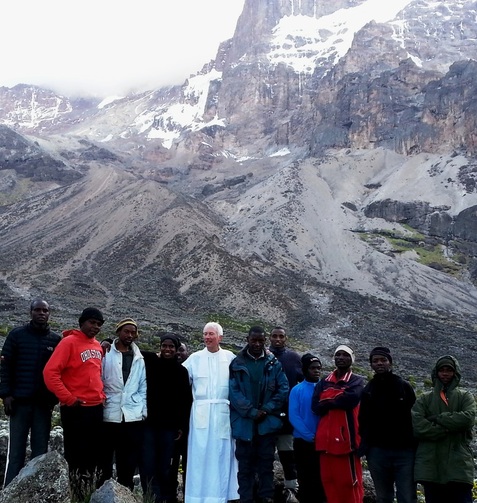 My mother, my sister, Camille, and I after my first Mass on June 30, 1991
My mother, my sister, Camille, and I after my first Mass on June 30, 1991 In Rome a great basilica dominates the city even 17 centuries after the first Christian emperor built it over a poor man’s shallow grave. Driving into Rome on the A24 from the Apennine Hills, before you can distinguish any other single building, you can pick out St. Peter’s Dome punctuating the skyline of the Eternal City. Once inside, you can look straight up almost 500 feet into Michelangelo’s cupola, and then down into the crypt 30 feet beneath the papal altar. A plumb line dropped from the center of that dome would pass through the middle of the altar and straight through the tomb of St. Peter, whose bones are kept in 24 Plexiglas boxes below the altar. Peter was martyred near that spot in the year 64, and his body flung into a hastily-dug grave. Over that grave, the entire basilica, and really the whole Church, eventually developed its magnificent form. Finally, in six-foot tall lettering circling the inner barrel of St. Peter’s vast dome are these words in gold mosaic: “Tu es Petrus, et super hanc petram edificabo ecclesiam meam,” which are the words of Christ from today’s gospel: “You are Peter, and on this Rock I will build my Church.” Simon Bar Jonah, Jesus declares, I rename you “Rocky,” and upon this rock I will establish my kingdom on earth. Quite an honor for a simple fisherman from Galilee….
Ordination Anniversaries
Every five years each of the world’s 5000 bishops must make an “ad limina” visit to Rome—to meet with the Pope, but more importantly, to pray at the tombs of the apostles (ad limina means “to the shores,” that is, to the shores of the port city of Rome, where Peter and Paul were martyred and eleven of the Apostles are buried). Today, June 29, is the feast Saints Peter and Paul, both executed by the Emperor the same year. June 29 is also a popular day for priests to be ordained, that they might model their priestly service after that of those priests who watered the infant Church with their blood. Pope Benedict, for example, was ordained on this day in 1951, and forty years after him, I was ordained in 1991 by Bishop Donald Montrose in Stockton, California. We priests aspire to serve Christ, to love Christ, like Saints Peter and Paul, and we beg their prayers for our vocation. Please pray for Pope Benedict, 63 years a priest today, and throw in one for me if you get a chance.
Loosening Chains
Peter figures in both the traditional Mass’s Epistle and Gospel, but we don’t hear anything about poor old St. Paul. This imbalance is addressed in the reformed liturgy, in which we are also given a reading from 2 Timothy: “I, Paul, am already being poured out like a libation…. I have finished the race; I have kept the faith…. The Lord gave me strength, so that through me the proclamation might be completed and all the Gentiles might hear it. And I was rescued from the lion’s mouth. …To him be glory forever and ever. Amen.” Peter too exclaims in the Epistle that “Now I know for certain that the Lord sent his angel to rescue me from the hand of Herod.…” God rescued both Apostles from the “Lion’s mouth” several times, but only because both had already surrendered themselves to be “poured out like a libation.” Absolutely giving themselves to Christ (in the words of St. Paul, “to me life is Christ, and death is so much gain”), they were found adequate to the role of twin pillars for the nascent Church.
The Blood of Martyrs is Seed of the Church
And the essential purpose of these apostles? It was to “bind” and to “loose:” to bind up spiritual wounds with right doctrine, and to loose the chains of sin. Angels literally unlocked iron chains from Peter and Paul in their imprisonment, even as Christ had unlocked their spiritual chains by His blood. These men came to realize what God had done for them, and they threw themselves into the work of making known his name to all the world. By Christ’s authority, Peter binds us to right doctrine and right worship; by Christ’s authority he looses the shackles of sin from us. Like a good father, he holds us fast to the truth, and he shakes loose the toxins of error and sin from us. We are Roman Catholics, and we glory in the grace given these two Apostles for our salvation. In a culture dominated by relativism, we bind ourselves to the Truth of which they bore witness by their blood. This Truth is a Person, and this Person loves us. Let us love Him as did Peter and Paul, even to the shedding of our blood, should our testimony call for it.









 RSS Feed
RSS Feed